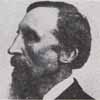Robert Jackson was born on August 27, 1856, at Fort Benton, Montana Territory. He was a Piegan Blackfoot Indian scout who was not present at the battle because he was discharged from service on June 25, 1876, at Fort Lincoln. For more about Robert Jackson and his younger brother and fellow scout William Jackson, see the Louis Riel Institute.
John E. Armstrong was a Private in Company A who was killed in the valley fight. He married Martha Hancock on August 27, 1856, in Philadelphia, Pennsylvania. They divorced, and his wife remarried in 1872. Armstrong’s father was awarded his pension in 1880.
John S. Wells died on August 27, 1893, in Bismarck, North Dakota, and was buried in the Fairview Cemetery in Bismarck. He was a Sergeant in Company E who was not present at the battle due to being on furlough, attending the Centennial Exposition in Philadelphia, Pennsylvania. After the battle, he used the name James Blanchard.
Walter Scott Sterland died on August 27, 1922, in Bismarck, Burleigh County, North Dakota, and was buried in the Dickinson Cemetery in Dickinson, Stark County, North Dakota. He was a Private in Company M who was not present at the battle due to detached service at Yellowstone Depot.
Darwin Elnathan Fisher Symms was born in Montreal, Quebec, Canada, on August 28, 1851, the son of Richard and Adaliza A. Symms. He was a Private in Company I who was killed with Custer’s Column. He is listed on the mass grave monument on Last Stand Hill, and there is a cenotaph in his honor at Burr Oak Cemetery in Burr Oak, Iowa.
John McGlone died on August 28, 1920, in the Barnes Hospital in Washington, D.C., and was buried in the Soldiers’ Home National Cemetery there. He was a Sergeant with Company M who participated in the valley and hilltop fights.
John Mullen died in San Francisco, California, on August 29, 1888, and was buried in the San Francisco National Cemetery at the Presidio. He was a Sergeant with Company L who was with the pack train and participated in the hilltop fight.
Charles Sanders died on August 29, 1915, in Lincoln, Nebraska, and is said to have been buried in the Wyuka Cemetery there. He was a Private in Company D who served as an orderly for Lt. Edgerly during the battle and participated in the hilltop fight.
John Sivertsen (left) died in Washington, D.C., on August 30, 1925, and was buried in the Soldiers’ Home National Cemetery there. He was a Private in Company M who participated in the valley and hilltop fights.
Samuel Berryhill Severs was born on August 31, 1854, in St. Louis, Missouri. He was a Private in Company H who was wounded during the hilltop fight.
Little Sioux (left) died in North Dakota on August 31, 1933, and, according to his headstone application, he was originally buried the Fort Berthold Cemetery in Nishu, North Dakota. A marker for him is in the Indian Scout Cemetery, in McLean County, North Dakota, so he may have been reinterred there. He was a Scout who was with Reno’s Column during the valley fight.
Thomas James Finnegan [gravestone has Finegan] was born on September 2, 1850, in Hillsboro, Ohio. He was a Private in Company M who was not present at the battle due to detached service with the wagon train at Powder River, Montana.
Jacob Deihle died in Washington, D.C., on September 2, 1885, and was buried in the Soldiers’ Home National Cemetery there. He was a Sergeant with Company L who was with the pack train and participated in the hilltop fight, during which he received a gunshot wound in his left cheek, causing him to lose four teeth.
James P. Boyle died on September 2, 1920, in Bismarck, North Dakota, and was buried there on September 4 in St. Mary’s Cemetery. He was a Private in Company G who participated in the valley and hilltop fights, where he was wounded in his back.

